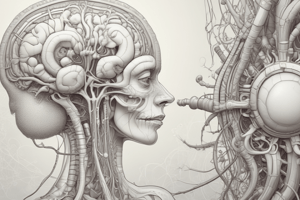Podcast
Questions and Answers
Which developmental anomaly is characterized by the absence of skull and brain?
Which developmental anomaly is characterized by the absence of skull and brain?
- Spina bifida
- Cerebral aqueduct stenosis
- Dandy-Walker malformation
- Anencephaly (correct)
What is the primary factor associated with neural tube defects?
What is the primary factor associated with neural tube defects?
- Low calcium levels
- Low folate levels (correct)
- High vitamin D levels
- High iron levels
What condition results from the failure of the posterior vertebral arch to close?
What condition results from the failure of the posterior vertebral arch to close?
- Meningocele
- Spina bifida (correct)
- Cerebral aqueduct stenosis
- Arnold-Chiari malformation
Which presentation is typical for spina bifida occulta?
Which presentation is typical for spina bifida occulta?
What is the most common cause of hydrocephalus in newborns?
What is the most common cause of hydrocephalus in newborns?
What anatomical feature is primarily affected in Dandy-Walker malformation?
What anatomical feature is primarily affected in Dandy-Walker malformation?
Which of the following is a consequence of Arnold-Chiari malformation?
Which of the following is a consequence of Arnold-Chiari malformation?
In the context of hydrocephalus, what is a typical physical sign?
In the context of hydrocephalus, what is a typical physical sign?
Flashcards
Neural tube defects
Neural tube defects
Incomplete closure of the neural tube during early embryonic development.
Anencephaly
Anencephaly
Absence of the skull and brain, a severe neural tube defect.
Spina bifida
Spina bifida
Failure of the posterior vertebral arch to close, causing a vertebral defect.
Spina bifida occulta
Spina bifida occulta
Signup and view all the flashcards
Cerebral aqueduct stenosis
Cerebral aqueduct stenosis
Signup and view all the flashcards
Dandy-Walker malformation
Dandy-Walker malformation
Signup and view all the flashcards
Arnold-Chiari malformation (Type I)
Arnold-Chiari malformation (Type I)
Signup and view all the flashcards
Meningomyelocele
Meningomyelocele
Signup and view all the flashcards
Study Notes
Neural Tube Defects
- Neural tube formation begins early in gestation, running along the embryo's cranial-caudal axis.
- The tube's wall becomes the central nervous system, while the hollow lumen forms the ventricles and spinal cord.
- Neural crest forms the peripheral nervous system.
- Defects are linked to low folate levels before conception.
- Prenatal detection can occur through elevated AFP levels in amniotic fluid/maternal blood.
- Anencephaly involves missing skull and brain tissue, leading to a "frog-like" appearance and maternal polyhydramnios.
- Spina bifida is a posterior vertebral arch closure failure, leading to vertebral defects.
- Spina bifida occulta shows a dimple or patch of hair over the affected area.
- Spina bifida with protrusion presents a cystic bulge of underlying tissue (meningocele or meningomyelocele).
Cerebral Aqueduct Stenosis
- This is a congenital narrowing of the CSF-draining channel from the 3rd to the 4th ventricle.
- It causes CSF buildup, most often resulting in newborn hydrocephalus.
- CSF is produced by the choroid plexus within the ventricles.
- CSF flows from lateral ventricles to the 3rd ventricle through the interventricular foramina.
- CSF flows from the 3rd ventricle to the 4th ventricle via the cerebral aqueduct.
- CSF flows from the 4th ventricle to the subarachnoid space through foramina of Munro, Magendie, and Luschka
Dandy-Walker Malformation
- There's a failure of cerebellum vermis development and enlargement of the 4th ventricle.
- Absence of cerebellum, frequently causing hydrocephalus.
Arnold-Chiari Malformation (Type II)
- Cerebellar vermis and tonsils are displaced downwards through the foramen magnum.
- CSF flow obstruction frequently causes hydrocephalus.
- Often linked to meningomyelocele.
Studying That Suits You
Use AI to generate personalized quizzes and flashcards to suit your learning preferences.
Related Documents
Description
Explore key concepts regarding neural tube defects and cerebral aqueduct stenosis, critical conditions in development. Learn about their formation, causes, and prenatal detection methods, including specific conditions such as anencephaly and spina bifida. This quiz will help solidify your understanding of these important topics in human anatomy and embryology.




